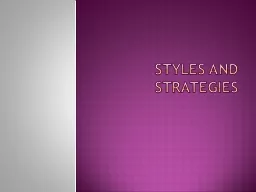

Process style and strategy Process the most general concept all human beings engage in certain universal processes Style consistence enduring tendencies or ID: 431974
Download Presentation The PPT/PDF document "Styles and strategies" is the property of its rightful owner. Permission is granted to download and print the materials on this web site for personal, non-commercial use only, and to display it on your personal computer provided you do not modify the materials and that you retain all copyright notices contained in the materials. By downloading content from our website, you accept the terms of this agreement.
Slide1
Styles and strategiesSlide2
Process, style and strategy
Process: the most general concept
all human beings engage in certain
universal processes
Style: consistence enduring tendencies or
preferences within an individual
Strategies: specific methods of approaching a
problem for achieving a particular
endSlide3
Learning styles
Cognitive style:
The link between personality and cognition
Learning style:
The link between cognition and educational context. It mediates between emotion and cognitionSlide4
Learning styles are:
1- Reflexive
:
Out of reflexive personality
2-
Impulsive
Out of impulsive emotional personalitySlide5
People’s styles are determined by:
They way they internalize their environment
Because of that physical, affective and cognitive domains merge in learning stylesSlide6
Are styles stable?
Different contexts evoke different stylesSlide7
There are 9 styles of language acquisition:
1. Field independence-dependence
2. Random
vs
sequential
3. global
vs
particular
4. inductive
vs
deductive
5.
synthetic
vs
analytic
6.analogue
vs
digital
7. concrete
vs
abstract
8. levelling
vs
sharpening
9. impulsive
vs
reflectiveSlide8
Other styles include:
Left-and right-bin styles
Ambiguity tolerance
Visual; auditory/
kinesthetic
styles Slide9
The differences between FI &FD
FI
The ability to perceive a particular relevant tem or factor in a field of distracting items
FD
The tendency to be dependent on the total field so that the parts embedded within the field are not easily
percievedSlide10
Enables you to distinguish parts from the whole
FI persons are more independent, competitive and self-confident
Enables you to perceive the whole picture of a problem or idea or event
FD persons are more socialized perceptive of others’ feelingsSlide11
Related to analysis- attention to details- mastering of exercising drills and focused activities
Related to communicative aspects of language learningSlide12
Which is more important FI OR FD?
the answer is both
Depending on the context of learning
Learners invokes the appropriate style
Teachers understand preferences of styles and be
flixableSlide13
Lift-and-right-brain dominance
Lift-brain
Logical analytic thought mathematical processing of information
Deductive style of teaching
Right brain
Visual auditory images processes holistic Lift-and-right-brain
dominance
emotional information
Inductive style of teaching Slide14
Ambiguity tolerance
vs
intolerance
Cognitive well to tolerate ideas that counter your belief system of knowledge
Too see every idea fitting in cognitive organization and rejection of other unfitting ideasSlide15
Reflectivity and impulsivity
Quick guess at answers to problem
Inductive methods
Slow calculated decisions
Deductive methods